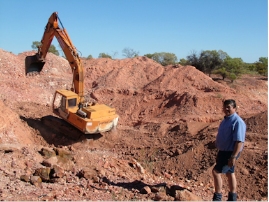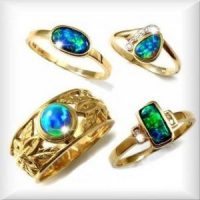Opal Mines
Opal Mines are not relics of the past

Most people are totally fascinated with the “good old days” of gold rushes and exploring. When I wandered the bush back in the 60’s’ I heard stories of the opal miners who combed this country back in the 1800’s.
The stories told of hardy men and women who seemed to be able to “smell” where the opal was. The work these miners did with a pick and shovel is unbelievable. Opal mines in White Cliffs, for example, look like the craters on the moon.
This is what opal mines look like when you start digging. You have to register a claim, which gives you your right to dig where you think you will find opal. In some ways, picking the right spot is like picking the winning lottery number.
In truth, this decision is often made by tossing a coin, though you’ll find many folks who insist they have special and reliable methods for determining where opal can be found. Amazingly, some of the older, experienced miners seem to be nearly able to “smell” opal.
Opal Mines-Two types of opal mines are dug in Australia: underground and open cut.
Underground mining, as the name implies, require sinking a shaft with a one meter round auger(drill). Well, that’s how it’s done today. Early miners dug their holes with a pick and shovel–and the old holes were rectangular in shape. How would you like to dig with a pick and a shovel at 110 degrees in the shade? The old miners did it all the time. There are thousands of holes or shafts like the ones below.
Underground miners work with hoists to haul mullock to the surface. Mullock is the whitish clay that must be removed from the mines so that the opal miner can get down to the opal bearing levels. In the early days, mullock was drawn to the surface in buckets tied to a windlass. It was a long and tedious job.
Open cut mining uses bulldozers and backhoes to cut wide furrows in the ground. Much of the open cut mining is found in the Queensland mining areas. Making a “cut” with a dozer saves a lot of pick and shovel work! Once again, the early miners cut these furrows by hand.
Both the underground and open cut opal fields are just full of mullock piles. Miners refer to these mounds as heaps. Interestingly, some of these waste heaps have proven to be a rich source of opal for tourists to find.
Once a miner removes the mullock and gets into the bearing level, he uses a technique called gouging to search for opal. Gouging means using a small pick to remove the dirt in the earth surrounding the stone. Before there was good lighting in the underground mines, the old timers used to listen for the special click sound that signaled when their pick hits either potch or precious stone.
Opal mining is not recommended for folks with claustrophobic tendencies! It can be very lonely down in the mines–and dangerous. Mining rules make it safer by requiring miners to prop the roof of the mine and to carefully leave the mine if the ceiling looks unstable. Unfortunately, it’s tempting to stay “just a little longer” if you’re onto some good gems. Many miners have lost their lives taking risks like this.
Unformed opal is called potch and it can range from no color to milky white to gray to black. This pan full of black potch is called tailings. Australia’s famous black opals are actually opal sitting on black potch. Always, the miner hopes to find some valuable gems among the worthless black potch.
Sadly, it’s been said, that 95% of opal found is valueless potch. Of the remaining five percent, 95% of that is low quality. The remaining bit can be termed precious opal. Miners commonly equate their situation to that of fishermen — too much water is mixed up with the fish; or, in the case of opal mines — too much potch is mixed up with the opal!
Opal Mines and Finished Jewelry
Opal Mines are a long way from the jewelry manufacturing side of things. The finished product is often not seen by the miners but with the help of sites like this, it is exposed to the world. Take a look here
More pics of the opal Mines

Our agitator set up at the Lightning Ridge opal fields.

This pile of dirt is one of many heaps of rubble. The results of a mountain of work at the opal mines in our area.

Giant Vacuum cleaner [A ‘blower’] makes it much easier to suck out the mullock so that it can be processed.

A typical scene showing opal mines in the foreground that is at present not being worked.

One meter sized hole dug by a Caldwell drill.

Young Max from Germany. Trying his hand at Lightning Ridge.

Graham out at the Opalton near Winton. Boulder opal country. Heavy equipment is required for this type of mining
Some examples of rough opal for sale to enthusiasts and hobbyists are here
So you can see that these mines in Australia are very much a part of the outback of the current century, although it must be said that a lot of the fields are starting to run out.
There is more demand is more than the supply at present and a lot of dealers are relying on stock they have had for many years.
The Boulder Opal mines are a slight exception to this and reasonable stocks are still being produced and you can see some examples of rough for sale here.







HI Peter
I’m starting to get some machinery together so how do you go about accessing land if it is owned privately to start my operation and do you drill a couple of small test holes to start to look at what comes up before you sink a shaft or bring in heavy machinery. I’m new to this
can u plz put when the opal miners are found and how many miners are there and were do miners live and why
Lilo, the boulder opal fields were first found in Queensland in the mid 1840s. Then came the other fields of White Cliffs in southern NSW, Coober Pedy in South Australia, Andamooka in South Australia, Lightning Ridge in NSW. There are a lot of other smaller mines too such as Lambina and Mintabie in South Australia, The Sheepyards, Grawin and other related fields in NSW not far from Lightning Ridge, and the southern boulder opal fields of Yowah and Koroit. I cannot tell you how many miners live there now. Once there used to be maybe a thousand or more but there is not so much opal being found anymore and there may be half that amount or even less at this time (2013) you can take a look here http://www.abc.net.au/news/2012-03-21/australias-historic-opal-industry-dying-off/3903310 for some information about this. It also tells you why people live there. Hope this helps Lilo, Peter
Tina, I’m not sure if i answered this inquiry. If not, so sorry. We have just had a large upgrade on our site and a few things needed adjusting. we have our own opal mines. if you want a small amount of rough opal, its no problem. If you can spend maybe $200 you can get a free copy of the ‘opal Bloke’ eBook as well here
How do I go about getting a claim and info on running and getting a opal mine at the ridge thanks
Hi was keen to get started mining a claim, with a partner could some body let me know the up front costs to actually climbing down the hole and digging.
E.g Mining courses, license
Test holes and shafts with a drilling rig
Ladders ,automatic hoist {bucket] or blower
Old workable tipper for transport of sandstone , clay
thanks.
Brett, where are you located? I assume you are talking about working at Lightning Ridge as this is really the only opal field appropriate for small miners. Queensland fields are a bit isolated and need big good quality excavators and equipment including camps. Lightning ridge mines are all fairly close to town, or at least to facilities and you can get plenty of repair support in town. just clarify that first.
I am in sydney and was referring yo Lightning Ridge.
Bret, the best idea is to take a trip to the Ridge sometime and just get talking with the locals. the club is a good place to start with or you can go over to nobby’s hotel. also go up the sheepyards or Grawin pub and get talking to the locals. Much of the opal digging is taking place at the Mulga field near Grawin. i think thats the best advice i can give about opal mining.
hi my name is a shaun im a young opal miner in lightning ridge my question is this when underground what are the clay signs to look for in the opal dirt to determine wen you are close to the dirt the forms the opal better where i am i have a 30+foot shin cracker roof with a 6 foot of baked opal dirt lvl under that then the softer more flaky clay is there with about 15 +feet of opal lvl b4 2nd lvl starts i have enjoyed the excitment opal mineing can bring and yet i have not found anything worth jumping up in the for im just in the need for some advice on what to look for thanks
Hi Shaun, sorry about the delay in getting back to you. Actually, my main profession is opal cutting and although I can guess at the answer to your question it would be better to have a chat to one of my opal mining partners out at Lightning Ridge. I assume that is where you are living. Just let me know if not. Actually, its often better to work along with someone else on a percentage basis because if you are starting out, you probably don’t have much equipment and getting results will be a lot slower. So just leave your email address in the contacts area of this site and i will introduce you to someone who will give you better advice. Best wishes Shaun. Peter
Could you please provide information regarding the mullock suction blower. I would like to know if it is custom-made or supplied ready to use, any supplier contact details, and a rough cost estimate if possible. If it is not readily available is there a specification and design overview I may access online?
Thanks,
Phil
Phil, its probably best if you take a trip to the Ridge and just ask around town. it wont be long before you will know everything there is to know about it. There is a guy called Kanut [not sure of the spelling of his name]out at the three mile who makes all sorts of machines and there are others in town doing it too. If you like you can leave a message by signing in to http://www.opals.co and we can talk direct by email. sorry i have to do this but i used to splatter my email address all over the net and i got buried in spam, so ive had to become a little less personal. but if you do that i will help you all i can to make the right contacts at the Ridge. Best wishes Phil, Peter